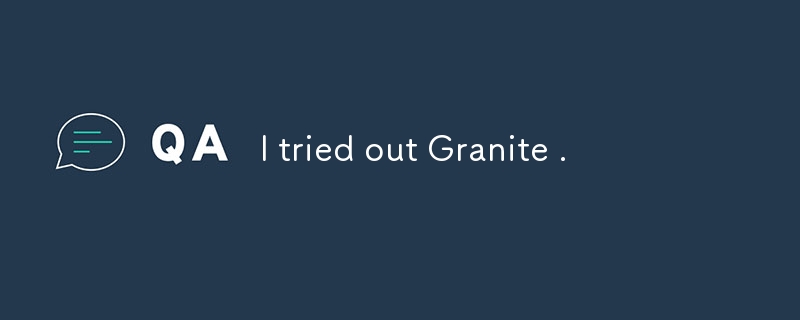我尝试过花岗岩。

花岗岩3.0
Granite 3.0 是一个开源、轻量级的生成语言模型系列,专为一系列企业级任务而设计。它原生支持多语言功能、编码、推理和工具使用,适合企业环境。
我测试了运行这个模型,看看它可以处理哪些任务。
环境设置
我在 Google Colab 中设置了 Granite 3.0 环境,并使用以下命令安装了必要的库:
!pip install torch torchvision torchaudio !pip install accelerate !pip install -U transformers
执行
我测试了Granite 3.0的2B和8B型号的性能。
2B型号
我运行了 2B 模型。这是 2B 模型的代码示例:
import torch
from transformers import AutoModelForCausalLM, AutoTokenizer
device = "auto"
model_path = "ibm-granite/granite-3.0-2b-instruct"
tokenizer = AutoTokenizer.from_pretrained(model_path)
model = AutoModelForCausalLM.from_pretrained(model_path, device_map=device)
model.eval()
chat = [
{ "role": "user", "content": "Please list one IBM Research laboratory located in the United States. You should only output its name and location." },
]
chat = tokenizer.apply_chat_template(chat, tokenize=False, add_generation_prompt=True)
input_tokens = tokenizer(chat, return_tensors="pt").to("cuda")
output = model.generate(**input_tokens, max_new_tokens=100)
output = tokenizer.batch_decode(output)
print(output[0])
输出
<|start_of_role|>user<|end_of_role|>Please list one IBM Research laboratory located in the United States. You should only output its name and location.<|end_of_text|> <|start_of_role|>assistant<|end_of_role|>1. IBM Research - Austin, Texas<|end_of_text|>
8B型号
将2b替换为8b即可使用8B模型。以下是 8B 模型的没有角色和用户输入字段的代码示例:
import torch
from transformers import AutoModelForCausalLM, AutoTokenizer
device = "auto"
model_path = "ibm-granite/granite-3.0-8b-instruct"
tokenizer = AutoTokenizer.from_pretrained(model_path)
model = AutoModelForCausalLM.from_pretrained(model_path, device_map=device)
model.eval()
chat = [
{ "content": "Please list one IBM Research laboratory located in the United States. You should only output its name and location." },
]
chat = tokenizer.apply_chat_template(chat, tokenize=False, add_generation_prompt=True)
input_tokens = tokenizer(chat, add_special_tokens=False, return_tensors="pt").to("cuda")
output = model.generate(**input_tokens, max_new_tokens=100)
generated_text = tokenizer.decode(output[0][input_tokens["input_ids"].shape[1]:], skip_special_tokens=True)
print(generated_text)
输出
1. IBM Almaden Research Center - San Jose, California
函数调用
我探索了函数调用功能,并使用虚拟函数对其进行了测试。这里,get_current_weather 被定义为返回模拟天气数据。
虚拟函数
import json
def get_current_weather(location: str) -> dict:
"""
Retrieves current weather information for the specified location (default: San Francisco).
Args:
location (str): Name of the city to retrieve weather data for.
Returns:
dict: Dictionary containing weather information (temperature, description, humidity).
"""
print(f"Getting current weather for {location}")
try:
weather_description = "sample"
temperature = "20.0"
humidity = "80.0"
return {
"description": weather_description,
"temperature": temperature,
"humidity": humidity
}
except Exception as e:
print(f"Error fetching weather data: {e}")
return {"weather": "NA"}
即时创作
我创建了一个调用该函数的提示:
functions = [
{
"name": "get_current_weather",
"description": "Get the current weather",
"parameters": {
"type": "object",
"properties": {
"location": {
"type": "string",
"description": "The city and country code, e.g. San Francisco, US",
}
},
"required": ["location"],
},
},
]
query = "What's the weather like in Boston?"
payload = {
"functions_str": [json.dumps(x) for x in functions]
}
chat = [
{"role":"system","content": f"You are a helpful assistant with access to the following function calls. Your task is to produce a sequence of function calls necessary to generate response to the user utterance. Use the following function calls as required.{payload}"},
{"role": "user", "content": query }
]
响应生成
使用以下代码,我生成了一个响应:
instruction_1 = tokenizer.apply_chat_template(chat, tokenize=False, add_generation_prompt=True)
input_tokens = tokenizer(instruction_1, return_tensors="pt").to("cuda")
output = model.generate(**input_tokens, max_new_tokens=1024)
generated_text = tokenizer.decode(output[0][input_tokens["input_ids"].shape[1]:], skip_special_tokens=True)
print(generated_text)
输出
{'name': 'get_current_weather', 'arguments': {'location': 'Boston'}}
这证实了模型能够根据指定城市生成正确的函数调用。
增强交互流程的格式规范
Granite 3.0 允许格式规范以促进结构化格式的响应。本节解释如何使用 [UTTERANCE] 进行回应,使用 [THINK] 进行内心想法。
另一方面,由于函数调用以纯文本形式输出,因此可能需要实现单独的机制来区分函数调用和常规文本响应。
指定输出格式
以下是指导 AI 输出的示例提示:
prompt = """You are a conversational AI assistant that deepens interactions by alternating between responses and inner thoughts. <Constraints> * Record spoken responses after the [UTTERANCE] tag and inner thoughts after the [THINK] tag. * Use [UTTERANCE] as a start marker to begin outputting an utterance. * After [THINK], describe your internal reasoning or strategy for the next response. This may include insights on the user's reaction, adjustments to improve interaction, or further goals to deepen the conversation. * Important: **Use [UTTERANCE] and [THINK] as a start signal without needing a closing tag.** </Constraints> Follow these instructions, alternating between [UTTERANCE] and [THINK] formats for responses. <output example> example1: [UTTERANCE]Hello! How can I assist you today?[THINK]I’ll start with a neutral tone to understand their needs. Preparing to offer specific suggestions based on their response.[UTTERANCE]Thank you! In that case, I have a few methods I can suggest![THINK]Since I now know what they’re looking for, I'll move on to specific suggestions, maintaining a friendly and approachable tone. ... </output example> Please respond to the following user_input. <user_input> Hello! What can you do? </user_input> """
执行代码示例
生成响应的代码:
chat = [
{ "role": "user", "content": prompt },
]
chat = tokenizer.apply_chat_template(chat, tokenize=False, add_generation_prompt=True)
input_tokens = tokenizer(chat, return_tensors="pt").to("cuda")
output = model.generate(**input_tokens, max_new_tokens=1024)
generated_text = tokenizer.decode(output[0][input_tokens["input_ids"].shape[1]:], skip_special_tokens=True)
print(generated_text)
示例输出
输出如下:
[UTTERANCE]Hello! I'm here to provide information, answer questions, and assist with various tasks. I can help with a wide range of topics, from general knowledge to specific queries. How can I assist you today? [THINK]I've introduced my capabilities and offered assistance, setting the stage for the user to share their needs or ask questions.
[UTTERANCE] 和 [THINK] 标签已成功使用,允许有效的响应格式。
根据提示的不同,输出中有时可能会出现结束标签(例如[/UTTERANCE]或[/THINK]),但总的来说,一般都可以成功指定输出格式。
流式传输代码示例
让我们看看如何输出流响应。
以下代码使用 asyncio 和线程库来异步传输来自 Granite 3.0 的响应。
!pip install torch torchvision torchaudio !pip install accelerate !pip install -U transformers
示例输出
运行上述代码将生成以下格式的异步响应:
import torch
from transformers import AutoModelForCausalLM, AutoTokenizer
device = "auto"
model_path = "ibm-granite/granite-3.0-2b-instruct"
tokenizer = AutoTokenizer.from_pretrained(model_path)
model = AutoModelForCausalLM.from_pretrained(model_path, device_map=device)
model.eval()
chat = [
{ "role": "user", "content": "Please list one IBM Research laboratory located in the United States. You should only output its name and location." },
]
chat = tokenizer.apply_chat_template(chat, tokenize=False, add_generation_prompt=True)
input_tokens = tokenizer(chat, return_tensors="pt").to("cuda")
output = model.generate(**input_tokens, max_new_tokens=100)
output = tokenizer.batch_decode(output)
print(output[0])
此示例演示了成功的流式传输。每个token都是异步生成并顺序显示,让用户可以实时查看生成过程。
概括
Granite 3.0 即使使用 8B 型号也能提供相当强的响应。函数调用和格式规范功能也运行良好,表明其具有广泛的应用潜力。
以上是我尝试过花岗岩。的详细内容。更多信息请关注PHP中文网其他相关文章!

热AI工具

Undresser.AI Undress
人工智能驱动的应用程序,用于创建逼真的裸体照片

AI Clothes Remover
用于从照片中去除衣服的在线人工智能工具。

Undress AI Tool
免费脱衣服图片

Clothoff.io
AI脱衣机

AI Hentai Generator
免费生成ai无尽的。

热门文章

热工具

记事本++7.3.1
好用且免费的代码编辑器

SublimeText3汉化版
中文版,非常好用

禅工作室 13.0.1
功能强大的PHP集成开发环境

Dreamweaver CS6
视觉化网页开发工具

SublimeText3 Mac版
神级代码编辑软件(SublimeText3)

热门话题
 如何解决Linux终端中查看Python版本时遇到的权限问题?
Apr 01, 2025 pm 05:09 PM
如何解决Linux终端中查看Python版本时遇到的权限问题?
Apr 01, 2025 pm 05:09 PM
Linux终端中查看Python版本时遇到权限问题的解决方法当你在Linux终端中尝试查看Python的版本时,输入python...
 在Python中如何高效地将一个DataFrame的整列复制到另一个结构不同的DataFrame中?
Apr 01, 2025 pm 11:15 PM
在Python中如何高效地将一个DataFrame的整列复制到另一个结构不同的DataFrame中?
Apr 01, 2025 pm 11:15 PM
在使用Python的pandas库时,如何在两个结构不同的DataFrame之间进行整列复制是一个常见的问题。假设我们有两个Dat...
 如何在10小时内通过项目和问题驱动的方式教计算机小白编程基础?
Apr 02, 2025 am 07:18 AM
如何在10小时内通过项目和问题驱动的方式教计算机小白编程基础?
Apr 02, 2025 am 07:18 AM
如何在10小时内教计算机小白编程基础?如果你只有10个小时来教计算机小白一些编程知识,你会选择教些什么�...
 如何在使用 Fiddler Everywhere 进行中间人读取时避免被浏览器检测到?
Apr 02, 2025 am 07:15 AM
如何在使用 Fiddler Everywhere 进行中间人读取时避免被浏览器检测到?
Apr 02, 2025 am 07:15 AM
使用FiddlerEverywhere进行中间人读取时如何避免被检测到当你使用FiddlerEverywhere...
 哪些流行的Python库及其用途?
Mar 21, 2025 pm 06:46 PM
哪些流行的Python库及其用途?
Mar 21, 2025 pm 06:46 PM
本文讨论了诸如Numpy,Pandas,Matplotlib,Scikit-Learn,Tensorflow,Tensorflow,Django,Blask和请求等流行的Python库,并详细介绍了它们在科学计算,数据分析,可视化,机器学习,网络开发和H中的用途
 Uvicorn是如何在没有serve_forever()的情况下持续监听HTTP请求的?
Apr 01, 2025 pm 10:51 PM
Uvicorn是如何在没有serve_forever()的情况下持续监听HTTP请求的?
Apr 01, 2025 pm 10:51 PM
Uvicorn是如何持续监听HTTP请求的?Uvicorn是一个基于ASGI的轻量级Web服务器,其核心功能之一便是监听HTTP请求并进�...
 Python中如何通过字符串动态创建对象并调用其方法?
Apr 01, 2025 pm 11:18 PM
Python中如何通过字符串动态创建对象并调用其方法?
Apr 01, 2025 pm 11:18 PM
在Python中,如何通过字符串动态创建对象并调用其方法?这是一个常见的编程需求,尤其在需要根据配置或运行...







